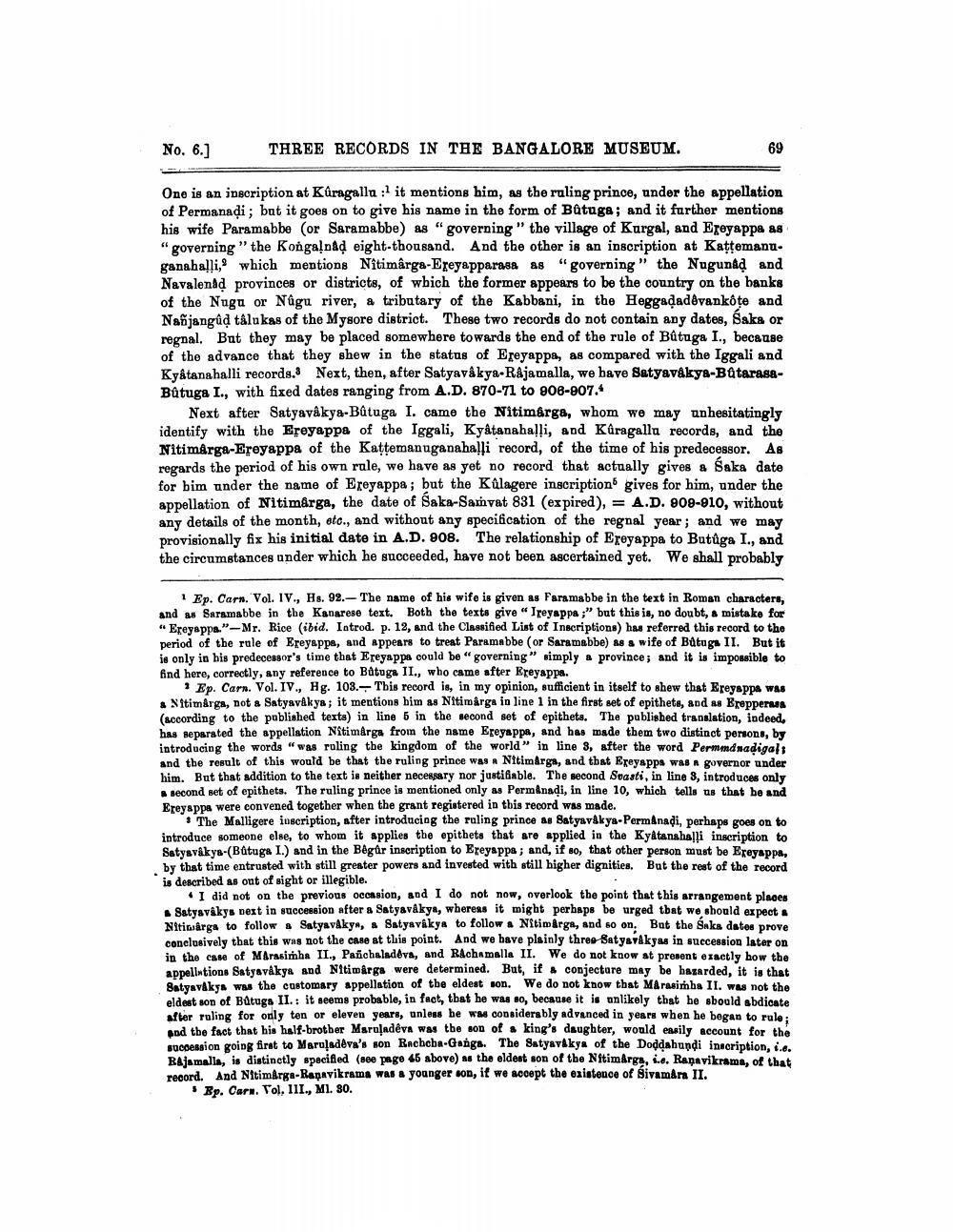________________
No. 6.]
THREE RECORDS IN THE BANGALORE MUSEUM.
69
One is an inscription at Karagalla: it mentions him, as the ruling prince, under the appellation of Permanadi; but it goes on to give his name in the form of Batuga; and it further mentions his wife Paramabbe (or Saramabbe) as "governing" the village of Kurgal, and Eroyappa 88 “ governing "the Kongaldad eight-thousand. And the other is an inscription at Kattemanu. ganahalli, which mentions Nîtimârga-Ereyapparasa as "governing" the Nugunad and Navalenád provinces or districts, of which the former appears to be the country on the banks of the Nugu or Nagu river, a tributary of the Kabbani, in the Heggadadávankote and Nanjangủa tâlukas of the Mysore district. These two records do not contain any dates, Saka or regnal. But they may be placed somewhere towards the end of the rule of Batuga I., because of the advance that they shew in the status of Ereyappa, as compared with the Iggali and Kyâtanahalli records. Next, then, after Satyavákya-Rajamalla, we have Setyavákya-BâtarasaBatuga I., with fixed dates ranging from A.D. 870-71 to 908-907.
Next after Satyavákya-Bâtuga I. came the Nitimêrge, whom we may unhesitatingly identify with the Ereyappa of the Iggali, Kyatanahalli, and Kûragallu records, and the NitimArga-Ereyappa of the Kattemanuganahalți record, of the time of his predecessor. As regards the period of his own rule, we have as yet no record that actually gives a Saka date for bim under the name of Ereyappa ; but the Kûlagere inscription gives for him, under the appellation of Nitimärga, the date of Saka-Samvat 831 (expired), = A.D. 909-910, without any details of the month, etc., and without any specification of the regnal year; and we may provisionally fix his initial date in A.D. 908. The relationship of Ereyappa to Butúga I., and the circumstances under which he succeeded, have not been ascertained yet. We shall probably
1 Ep. Carn. Vol. IV., Hs. 92. The name of his wife is given as Faramabbe in the text in Roman characters, and as Saramabbe in the Kaparese text. Both the texts give "Treyappa ;" but this is, no doubt, a mistake for "Ereyappa." -Mr. Rice (ibid. Introd. p. 12, and the Classified List of Inscriptions) has referred this record to the period of the rule of Ereyappa, and appears to treat Paramabbe (or Saramabbe) as a wife of Batuga II. But it is only in his predecessor's time that Ereyappa could be "governing" simply a province; and it is impossible to find here, correctly, any reference to Batuga II., who came after Kreyappa.
Ep. Carn. Vol. IV., Hg. 103. This record is, in my opinion, sufficient in itself to shew that Ereyappa was Nitimarga, not a Satyavákya; it mentions him as Nitimarga in line 1 in the first set of epithets, and as Ereppers (sccording to the published texts) in line 5 in the second set of epithets. The published translation, indeed has separated the appellation Nitimarga from the name Ereyappa, and has made them two distinct persons, by introducing the words "was ruling the kingdom of the world” in line 3, after the word Permmdnadigal and the result of this would be that the ruling prince was a Nitimarga, and that Ereyappa was a governor under him. But that addition to the text is neither necessary nor justifiable. The second Soasti, in line 8, introduces only
second set of epithets. The ruling prince is mentioned only as Permånadi, in line 10, which tells us that be and Ereyappa were convened together when the grant registered in this record was made.
The Malligere inscription, after introducing the raling prince as Satyavákya-Permånadi, perhaps goes on to introduce someone else, to whom it applies the epithets that are applied in the Kytanahalli inscription to Satyavákye-(Batuga I.) and in the Bégar inscription to Ereyappa ; and, if so, that other person must be Ereyappa, by that time entrusted with still greater powers and invested with still higher dignities. But the rest of the record is described as out of sight or illegible.
4 I did not on the previous occasion, and I do not now, overlook the point that this arrangement places Satyavákys next in succession after a Satyavákya, whereas it might perhaps be urged that we should expect Nitinarga to follow & Satyaváky, & Satyavákya to follow a Nitimarge, and so on. But the saka dates prove conclusively that this was not the case at this point. And we have plainly three Satyavákyas in succession later on in the men of Marasimha II., Panchaladva, and Rachamalla II. We do not know at prenent exactly how the appellations Satyavákya and Nitimarga were determined. But, if . conjectare may be hazarded, it is that Satyavákya was the customary appellation of the eldest son. We do not know that Marasimha II. was not the eldest son of Batuga II. : it seems probable, in fact, that he was so, because it is unlikely that he sbould abdicate after ruling for only ten or eleven years, unless he was considerably advanced in years when he began to rule : and the fact that his half-brother Maruladeva was the son of a king's daughter, would easily account for the Buceksion going first to Maruladeva's son Rachcba-Gangs. The Satyavákya of the Doddahundi inscription, i.e. BAjamalla, is distinctly specified (see page 45 above) as the eldest son of the Nitimarge, 1... Raņavikrama, of that record. And Nitimarga-Ranavikrama was a younger son, it we accept the existence of Sivamara II.
Ep. Carn. Vol. 11I., M. 80.




